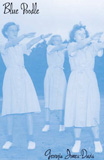September 30, 2011BLUE POODLE
Kathi Stafford
Finishing Line Press
P.O. Box 1626
Georgetown, Kentucky 40324
ISBN 1-59924-772-0
29 pp., $14.00
www.finishinglinepress.com
Blue Poodle, a recently released chapbook of poems by Georgia Jones-Davis, provides the reader with a rich variety of images, woven together in surprising and provocative rhythms. Some of these poems focus on the relationship between mother and child, but they are so expertly rendered in Jones-Davis’ unique voice that stereotypes are sidestepped.
For example, in “Put Me Away,” an aging mother echoes the sentiment of Sharon Olds in “I Go Back to May 1937”: “Do what you are going to do.” The woman in “Put Me Away” is not a cheery mother: “From the beginning/you emptied my life./ Now you empty my house–/ one chair, one table,/one tooth at a time. / You take everything—gold rings, the shoe-maker, France.” As a mother, I read these lines and worry about whether this witty recitation might one day be my own. The speaker recalls that “My childhood was gassed,/not my body,” summing up the violence she has survived only to feel trapped and resentful in her later years.
Next, the mother also rails against the oxygen tube that makes her feel like a dog on a leash—as well as her recognition that she wanted the “roller-skating girl/I was/when I was taken away/from me.” The enormous anger of the mother rolls over this portrayal: “I gained only thirteen pounds/with you./ I barely gave birth/to you at all.” Her separation from her own body and the child of her own body is a bleak evocation of a broken chord between self-identity and maternal responsiveness. An underlying question is the extent to which mothers seek a mirror image of themselves in their daughters.
Another poem that is especially effective is “Blue Poodle,” the title poem. A mother and a daughter wear matching dresses with strong implications. Having subjected my own daughter to matching outfits until she put her seven-year-old foot down, I was intrigued by the symbolism, as well as the personal connection I felt to this subject. The poem opens with these lines: “You are girdled in your mother’s/Navajo concho belt,/the black leather sleek.” Already the weight and restriction of the heavy belt pushes down on the reader.
Later in this poem, Jones-Davis moves on to a striking comparison between a mother and daughter: “At the governor’s tea you modeled/mother-daughter squaw dresses,/pale pink with silver bric-a-brac,/ flared by crinoline petticoats. How smug/and pretty she looked, how they flashed,/ her conchos, when she swirled./ Always small in your mother’s eyes.” The symbolism of the dress as a social front one wears in society is powerful in the vision of “squaw dresses” and their implicit subjugation to the masculine governor. The mother holds the power of beauty, while the daughter knows she is “always small” in the eyes of her mother.
I called my daughter as soon as I read this poem, worried I’d done permanent damage to her psyche with the whole matching dress routine. She assured me that she recalled our peach and pink flared dresses with pleasure, as well as the red outfits with Christmas trees on them. She admitted that she had liked these dresses, but that one day, “I just wanted to blend in at a certain age. You never blend in when you’re wearing the same dress as your mom, you know.”
The image of the red and black plaid dresses that she had rejected at the time flashed into my mind. I remember bribing her with pixie sticks a couple of times to get her to wear them, but those dresses were the end of the look-alike era.
Next, Jones-Davis recalls the odd blue poodle toy her mother got her when she was seven: “Valentine’s Day./ The legs moved, head swiveled,/ its tongue was a fleck of bright red flannel,/ the cloth of its body trunk velveteen, the curls of its fur/ the color of sky/ at the first sign of snow.” Mothers and their gifts are sometimes innocent, sometimes weighted with conflict and turmoil.
The conclusion moves on to hold up those conchos from the belt as “full moons that rule the roots of warring women, / unblinking eyes of the sleepless shark,/ scalloped blossoms tarnished by years of freezes.” This brilliant comparison plays out the conflict between mother and daughter, the shark of bad dreams, and the “years of freezes” that have damaged the unending vines that tie these women together.
These narrative poems are only two examples of the depth and symbolic riches that flash in this remarkable collection. Jones-Davis has demonstrated her keen eye again and again throughout this work.